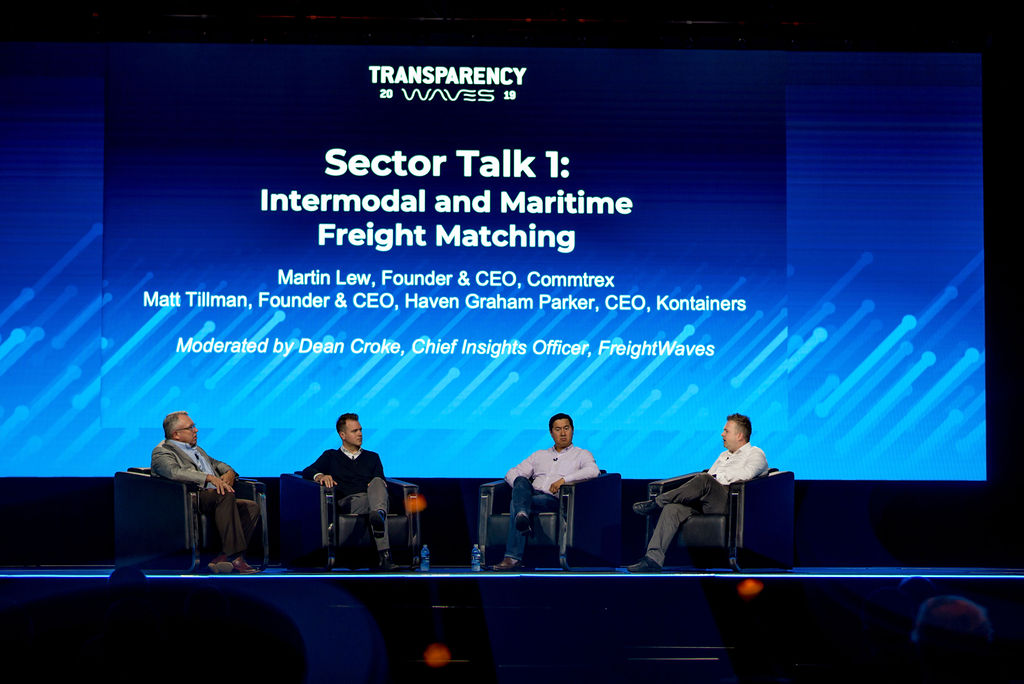Trading in an opaque rate market is ending as shippers gain more visibility.
Pricing, procuring and planning ocean and rail freight was for years a dark art practiced by a cabal of freight forwarders and logistics professionals.
But the ethos of many transport tech start-ups is making those once opaque tasks more easily accessible.
Kontainers Chief Executive Graham Parker said during a panel discussion at Transparency 19 that “the days of arbitraging freight rates are pretty much gone.”
He added, “A lot of freight brands that are keeping their heads down regarding technology will find the market in five years will be very different. There’s a natural culling of freight forwarders that are not adopting technology.”
Kontainers’ software-as-a-service (SaaS) product allows ocean carriers and freight forwarders to create online dashboards for quoting, booking and other services. Among its customers are Maersk (Nasdaq OMX: MAER) and Toll Group.
While the ocean freight industry is moving in the right direction, Parker said there’s still “a lot of work to do” in how customers quote, book and track marine containers.
The many legs of moving a marine container, including booking truck and rail space and clearing customs, make ocean freight “quite complex” and resistant to technological innovation.
Some of those legs still rely on electronic data interchange [EDI] to transmit information about a box moving through those various steps.
In addition to using Kontainers’ own application programming interface (API) for linking those steps, “a lot of customers still connect with EDIs going back to the 1970s.”
But customer demand for better visibility is forcing ocean freight to adopt more technology. Kuehne + Nagel (SIX: KNIN), the world’s largest ocean freight forwarder, launched an array of digital products aimed at increasing visibility in ocean freight, Parker said.
About two-thirds of ocean freight capacity is sold by intermediaries, said Matt Tillman, Chief Executive Officer of Haven, a developer of artificial intelligence software for logistics. He said the additional visibility into freight “is good for beneficial cargo owners [BCOs], but terrible for everyone else in the supply chain.”
The advent of new SaaS tools and services allows BCOs to bring more of their logistics operations in-house. Likewise, carriers are looking to create additional services because moving a box is a largely commodity business.
“The carriers realize the only way to increase their stickiness with customers is to push out the intermediaries,” Tillman said.
Martin Lew, Chief Executive Officer of railcar leasing and storage marketplace Commtrex, said rail shipping faces the issue of generational change. Fleet managers are retiring, taking along with them years of folkloric knowledge of managing rail assets.
“Rail shipping has traditionally been a very closed environment with the knowledge staying within a small group,” Lew said. “Now you have this generational change and the amount of time to learn the industry is compressed.”
The change in management coincides with another major change in the U.S. railroad system – precision scheduled railroading (PSR).
Lew said PSR represents a major shift in how rail assets are managed. With Class I Railroads divesting railcars and storage yards, rail shippers will increasingly have to find, manage and store their own.
“A lot of new shippers don’t know how to do this,” Lew said.
He said the rail industry is “a bit behind in trucking” in terms of tracking and managing assets. But the development of positive train control (PTC) will allow shippers better visibility into where their railcars are located.
“Connectivity across rail has been very difficult,” Lew said. But PTC “will drive a much more informed market for how rail assets are moving.”
